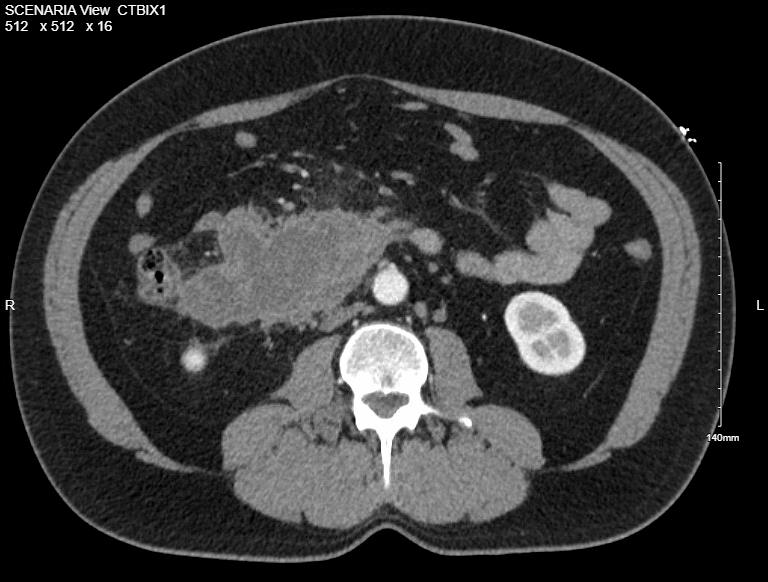Monday Poster Session
Category: Stomach and Spleen
P4260 - Gastric Outlet Obstruction Secondary to a Spontaneous Retroperitoneal Hematoma
Monday, October 27, 2025
10:30 AM - 4:00 PM PDT
Location: Exhibit Hall
- AJ
Ahmad Jaser, MD
Tallahassee Memorial HealthCare - - Tallahassee, FL
Tallahassee, FL
Presenting Author(s)
Ahmad Jaser, MD1, Jodi Wilson, MD1, Aaron J. Walker, MD2, Mownika Y. Walker, MD3
1Tallahassee Memorial HealthCare - - Tallahassee, FL, Tallahassee, FL; 2Florida State University College of Medicine at Tallahassee Memorial HealthCare, Tallahassee, FL; 3Florida State University, Tallahassee, FL
Introduction: Spontaneous retroperitoneal hematomas (SRHs) are rare in patients without trauma, coagulopathy and pancreatitis. When large and localized near the duodenum, they can mimic or induce a gastric outlet obstruction (GOO). We present a case of a healthy 44-year-old male with a SRH causing a GOO, in whom conservative management was pursued.
Case Description/
Methods: A 44-year-old man with no past medical history presented with four days of intractable nausea, vomiting and abdominal pain. Lipase was unremarkable, patient denied alcohol use and trauma. Initial computed tomography and magnetic resonance imaging revealed a 13 × 10 × 6 cm aperipancreatic hematoma encasing the second and third portions of the duodenum. Endoscopic ultrasound (EUS) revealed significant gastric retention and duodenal obstruction without evidence of retroperitoneal fluid. Despite GOO, the patient remained hemodynamically stable and was managed with total parenteral nutrition (TPN). Serial imaging showed progressive reduction in SRH size and the patient was discharged on TPN. Serial imaging surveillance completed after discharge demonstrated resolution of the GOO.
Discussion: SRHs are an uncommon clinical entity that can present a diagnostic challenge. The distinguishing feature of our case is its presentation in a previously healthy individual with no risk factors, thus making the diagnosis nonintuitive. The patient was hemodynamically stable and managed conservatively with nutritional support and serial imaging. This management strategy ultimately led to complete resolution of obstruction without the need for embolization or surgical intervention.
A recent case series described four patients with SRH-related duodenal obstruction, all managed conservatively with favorable outcomes and no recurrence, reinforcing the viability of non-surgical treatment in select patients. EUS played a diagnostic role in that series and in our case by helping to exclude a malignancy or active bleeding without the need for invasive interventions. This case underscores the importance of considering a SRH in the differential diagnosis of unexplained GOO, as well as emphasizing the potential for successful recovery by using conservative management in stable patients.

Figure: Contrast-enhanced axial CT angiography showing a large retroperitoneal fluid collection adjacent to the pancreatic head and duodenum, with heterogeneous attenuation consistent with hematoma. The lesion partially encases the descending and transverse portions of the duodenum, contributing to gastric outlet obstruction.
Disclosures:
Ahmad Jaser indicated no relevant financial relationships.
Jodi Wilson indicated no relevant financial relationships.
Aaron Walker indicated no relevant financial relationships.
Mownika Walker indicated no relevant financial relationships.
Ahmad Jaser, MD1, Jodi Wilson, MD1, Aaron J. Walker, MD2, Mownika Y. Walker, MD3. P4260 - Gastric Outlet Obstruction Secondary to a Spontaneous Retroperitoneal Hematoma, ACG 2025 Annual Scientific Meeting Abstracts. Phoenix, AZ: American College of Gastroenterology.
1Tallahassee Memorial HealthCare - - Tallahassee, FL, Tallahassee, FL; 2Florida State University College of Medicine at Tallahassee Memorial HealthCare, Tallahassee, FL; 3Florida State University, Tallahassee, FL
Introduction: Spontaneous retroperitoneal hematomas (SRHs) are rare in patients without trauma, coagulopathy and pancreatitis. When large and localized near the duodenum, they can mimic or induce a gastric outlet obstruction (GOO). We present a case of a healthy 44-year-old male with a SRH causing a GOO, in whom conservative management was pursued.
Case Description/
Methods: A 44-year-old man with no past medical history presented with four days of intractable nausea, vomiting and abdominal pain. Lipase was unremarkable, patient denied alcohol use and trauma. Initial computed tomography and magnetic resonance imaging revealed a 13 × 10 × 6 cm aperipancreatic hematoma encasing the second and third portions of the duodenum. Endoscopic ultrasound (EUS) revealed significant gastric retention and duodenal obstruction without evidence of retroperitoneal fluid. Despite GOO, the patient remained hemodynamically stable and was managed with total parenteral nutrition (TPN). Serial imaging showed progressive reduction in SRH size and the patient was discharged on TPN. Serial imaging surveillance completed after discharge demonstrated resolution of the GOO.
Discussion: SRHs are an uncommon clinical entity that can present a diagnostic challenge. The distinguishing feature of our case is its presentation in a previously healthy individual with no risk factors, thus making the diagnosis nonintuitive. The patient was hemodynamically stable and managed conservatively with nutritional support and serial imaging. This management strategy ultimately led to complete resolution of obstruction without the need for embolization or surgical intervention.
A recent case series described four patients with SRH-related duodenal obstruction, all managed conservatively with favorable outcomes and no recurrence, reinforcing the viability of non-surgical treatment in select patients. EUS played a diagnostic role in that series and in our case by helping to exclude a malignancy or active bleeding without the need for invasive interventions. This case underscores the importance of considering a SRH in the differential diagnosis of unexplained GOO, as well as emphasizing the potential for successful recovery by using conservative management in stable patients.

Figure: Contrast-enhanced axial CT angiography showing a large retroperitoneal fluid collection adjacent to the pancreatic head and duodenum, with heterogeneous attenuation consistent with hematoma. The lesion partially encases the descending and transverse portions of the duodenum, contributing to gastric outlet obstruction.
Disclosures:
Ahmad Jaser indicated no relevant financial relationships.
Jodi Wilson indicated no relevant financial relationships.
Aaron Walker indicated no relevant financial relationships.
Mownika Walker indicated no relevant financial relationships.
Ahmad Jaser, MD1, Jodi Wilson, MD1, Aaron J. Walker, MD2, Mownika Y. Walker, MD3. P4260 - Gastric Outlet Obstruction Secondary to a Spontaneous Retroperitoneal Hematoma, ACG 2025 Annual Scientific Meeting Abstracts. Phoenix, AZ: American College of Gastroenterology.
